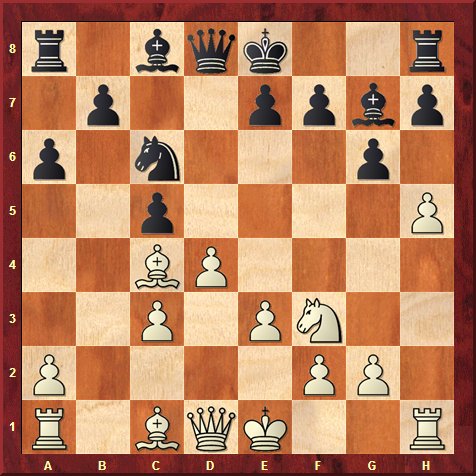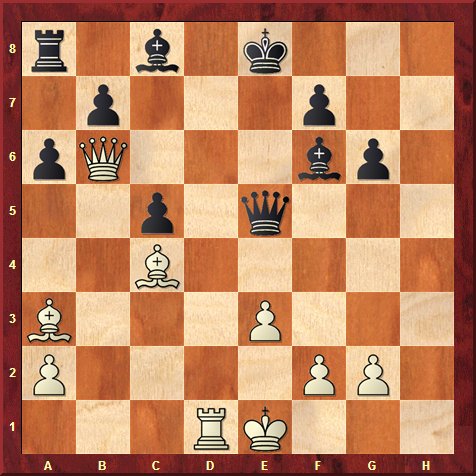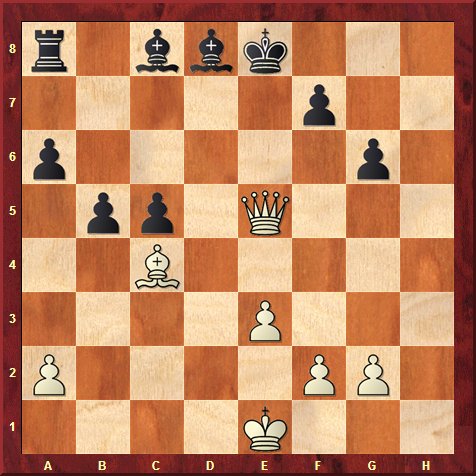All
the |
(Navigation bar
directly below.)
*******
© A.J. Goldsby, 2015.
(All rights reserved.)
****************
Click HERE
to see my
Chess Items.
****************
****************
Buy a book
from Amazon.com
(And help me out as well!)
****************
Click HERE
...
to see a list of the businesses that help to sponsor all of
my chess efforts.
CG
- "Problem of the Day"
(August 19th, 2009.)
Click HERE to see an explanation of the symbols that I commonly use when I annotate any chess game.
Click HERE to replay this game ... on another server. Click HERE to see a (PDF) copy of my analysis.
Click HERE to see a brief YT video on this game. (It's only around four minutes long!!)
NOTE: This was NOT a great game ... in fact on a scale of 1-to-10, it probably fits in somewhere above a three, but definitely under an eight. (IMO)
"So why annotate such a game?," you might ask. Good question! I annotated this game for many reasons, a few were:
-
It was there. (Two fairly decent players had played it, one player was over 2400 on the FIDE rating scale.) [More on FIDE ratings.]
-
This is exactly the kind of game that the <beginner-to-average player> could learn from. (Many fans have written to tell me that the "Super-GM" games are simply beyond their understanding ... unless - of course ... I provide copious notes. to such an encounter.)
-
The opening in this game, (The English); is tough to learn. There can be numerous transpositions, and the moves, analysis and variations can often seem to be dense, difficult, puzzling, and even (at times) ... downright contradictory.
In
lieu of the reasons stated above, I thought that this would be an excellent
opportunity ... ... ... TO TEACH! (Or at least - I could try.)
Thus, I present this game. (Enjoy!)
******************************
|
Saturday; September 26th, 2015: This game is very late in coming out and being finished. Why? I really don't have a clue, I guess I simply forgot about this game. It appears that I annotated it and began the web page ... but never finished it. I do know that in 2007, my wife became severely ill ... and passed away in January of 2008. (And ... for a long time afterward ... I was severely depressed, and did not finish many of the projects that I started.) Anyway, I recently found this game just sitting in a folder ... unfinished and undone. Since it appears that I am about to be homeless, I thought that I may as well try to finish formatting this game and put it out there on the Internet. (It seemed - to me - to be a waste, since I began the game, I should {eventually} try to finish it.) |
Konstantin Z. Lerner (2475) -
Fikret I Sideif_Sade (2320)
|
|
|
[A.J. Goldsby I]
This is the daily puzzle or ... "The Problem of The Day"
for Wednesday; August 19th, 2009.
White to move, (19. '?').
(NOTE: The CG website {currently} renders Black's last name as "Zade." {They later changed it.})
1.c4 Nf6; 2.Nc3 c5; 3.Nf3 d5!?;
A natural break in the center ... (!?)
Today,
both with the books and on the computer, this line's overall
rating is a little shaky.
(However, if Black plays very precise chess, it might be
a decent line for Black.)
[ Maybe better was:
3...e6; 4.g3,
"+/=" with only a small edge for White.
(The lines really begin to branch out from here, so I will halt my analysis at this point.)
[ See MCO-15, page # 707; beginning with column # 81. ]
**********************************************************************************
Or we can transpose to a Sicilian, (Accelerated Fianchetto and/or
The Maroczy Bind) with:
3...g6; 4.d4
cxd4;
5.Nxd4 Bg7; 6.e4 Nc6;
7.Be3, "+/=" 7...
0-0; "<=>" {Diagram?}
when master-level practice has borne out the fact that Black has good play from here.
[ See MCO-15, page # 287; columns # 7 & 8; and all the associated notes that go with these variations. ] ]
4.cxd5 Nxd5; 5.e3, (hits d4)
White plays a simple move, which supports central activity and also prepares the development of the White Bishop on f1.
(Which - in turn - would allow White to castle.)
[ Another way for White to proceed would have been the following line:
5.d4 Nxc3; 6.bxc3
g6; 7.e3 Bg7; 8.Bd3
0-0; 9.0-0 Qc7;
10.Rb1 b6; 11.Qe2
Rd8; 12.Be4!? Ba6!;
The end of the column.
13.c4 Nc6; "="
14.d5 f5!; "<=>"
... "with counterplay against White's strong center." - The authors / MCO.
GM Anatoly Karpov (2700) - GM Garry Kasparov
(2740); [A34]
FIDE (34th)
World Champ.'s
(KK#4) / Seville,
ESP; (Gm. #23);
16,12,1987.
{White won a tough game, 1-0 in 57.}
[ See MCO-15, page # 707; column # 79, and also note # (d.). ]
**********************************************************************************
Another popular line (for White) would be the following continuation:
5.g3 Nc6; 6.Bg2 Nc7;
7.0-0 e5; 8.d3
Be7; 9.Nd2, "+/=" with some pressure.
See the important game: GM Evgeny Tomashevsky (2684) - GM
Evgeny Najer (2669); [A34]
Sixteenth Russian Ch. (16th RUS-chT) /
Dagomys, (R#6); RUS /
09,04,2009.
{White won a difficult struggle, 1-0 in 65.} ]
5...Nxc3; 6.bxc3 g6; ('!?')
While this move is the first choice of the Fritz "Power-Book," I would have preferred (the more solid) 6...e6.
7.h4!?, (Against principles, but ...)
White plays a sharp, ambitious line.
(This is not bad, I am just not 100 per cent certain that it is positionally justified. Another note is that Fritz's evaluations drop enough to indicate that another move might have been better at keeping a small edge for White.)
[ Probably the more sane approach was called for here.
For example: >/= 7.d4 Bg7;
8.Bd3 0-0; 9.0-0,
"+/="
(with a nice center & good development) with a comfortable edge for White.
GM Vladimir Kramnik (2790) - GM Veselin Topalov (2740); [A34] /
Hoogovens / CORUS /
Wijk aan Zee, NED; (R#10) /
1998.
{A rather short
draw.} ]
Here play continues in a logical manner, that should be fairly easy (for any level of player) to grasp.
7...Bg7; 8.h5 Nc6; 9.Bc4 a6; 10.d4, (center)
White had to get this in ... sooner or later.
|
|
r1bqk2r/1p2ppbp/p1n3p1/2p4P/2BP4/2P1PN2/P4PP1/R1BQK2R b KQkq d3 0 10
Now we have a fairly complex position on the board, one that is somewhat atypical for the English.
[ Fritz prefers the following line:
RR 10.hxg6
hxg6; 11.Rxh8+ Bxh8;
12.Qb3 e6; 13.Be2
b5; 14.d4, '~'
(Unclear, maybe - "+/=")
however, I don't really see this as a valid improvement over the game.
]
Black now decides to rip things open ...
10...e5!?; ('?!')
Maybe a tad too ambitious.
[ Maybe an improvement would be: >/= 10...b5; 11.Bb3, "+/= - Fritz 11. ]
Now play enters a fairly forcing line.
(Black wins a Pawn, however - in return - White has excellent play.)
11.hxg6 hxg6; 12.Rxh8+ Bxh8;
13.Qb3 Qe7; 14.Ba3 exd4;
15.cxd4 Nxd4; 16.Nxd4 Bxd4;
17.Rd1 Bf6; 18.Qb6!,
This ties up Black's Q-side.
[ Also possible was: 18.Rc1!?, "+/=" ]
18...Qe5?;
This seemingly natural move, centralizing Black's Queen, turns out to be a mistake.
(Instead, Black had to find a way to try and develop his lagging Q-side.)
|
|
r1b1k3/1p3p2/pQ3bp1/2p1q3/2B5/B3P3/P4PP1/3RK3 w q - 0 19
We now have arrived at our position for the P.O.T.D. for Wed./Aug. 19th, 2009.
[ I never found a clear win for White after the following continuation:
>/= 18...Bg4!; 19.Bxc5
Rd8!; 20.Bb3! Rxd1+;
21.Bxd1 Bc3+;
22.Kf1 Qe4!?; 23.Bxg4
Qxg4; 24.Qd6 Qc4+;
25.Kg1±, ('+/') 25...Bf6;
"<=>"
when White is solidly better, yet there is no easy win lying about. ]
It is White to move in this position.
19.Bb2!,
First Black's Queen is attacked ... (with a skewer/X-ray/double attack on Black's Bishop on the f6-square.)
[ </= 19.Bb3? Kf8; etc. ]
19...Qxb2T; (Box.)
This is forced.
[ </= 19...Qe4??; 20.Qxf6, +- ]
20.Rd8+!,
Now the protector of Black's Queen - the Bishop on f6 - is decoyed.
(Black has no choice, but to capture the offending White Rook.)
20...Bxd8T; (No choice for Black.)
Once more - 100% forced.
[ </= 20...Ke7??; 21.Qd6#. ]
21.Qxb2,
Now Black has a fair amount of material for the lost Queen, however with all of his pieces trapped on the back row, Black has no real chance of successfully defending this position.
21...b5?; (Maybe - '??')
Black's position was not enviable, yet this move is a definite turkey.
[ RR
It was absolutely mandatory that Black play:
>/= 21...f6; (Maybe box.)
Now, with the move: 22.Qb1!, "+/-"
White should prevail. ]
22.Qe5+, "+/-" Black Resigns.
There wasn't any point in the second player continuing from the final position.
|
|
r1bbk3/5p2/p5p1/1pp1Q3/2B5/4P3/P4PP1/4K3 b q - 0 22
In most lines, Black is losing LOTS of material. (Like 22...Kd7; 23.Qd5+, which wins the Black Rook on a8.)
For more analysis and discussion on this game, please see the CG web page:
http://www.chessgames.com/perl/chessgame?gid=1553832.
Copyright (c) A.J. Goldsby, 2009. All rights reserved.
[ White is winning in all lines here.
Working out the exact variations
can be an instructive tactical exercise, especially for the beginner
or the {much} lower-rated player:
22.Qe5+ Be6; {"Box?"}
Apparently, this is forced.
************************************************************************
( A.)
Much worse is:
</= 22...Kf8?; 23.Qd5!, +-
and to save his King, Black will lose a lot of material.
* * * * * * * * *
B.) Obviously hopeless would be:
</= 22...Kd7?; 23.Qd5+, "+/-" and Black loses his Rook/a8.
* * * * * * * * *
C.) Also unattractive for Black would be the following line:
</= 22...Be7?!; 23.Bd5
Ra7; 24.Qb8,
+- & White is winning. )
************************************************************************
23.Bxe6 fxe6; 24.Qxe6+
Kf8; 25.Qc6 Ba5+;
26.Ke2 Rd8; 27.Qf6+!
Ke8; 28.Qxa6!, "+/-"
and Black will lose more buttons. ]
NOTE: Although I analyzed this game with other engines, I did re-check it with Houdini and DF-14 prior to posting this page.
Copyright (c) A.J. Goldsby, 2009. All rights reserved.
Copyright (c) A.J. Goldsby, 2011. All rights reserved.
Copyright (c) A.J. Goldsby, 2015. All rights reserved.
1 - 0
The analysis for this page was prepared with the excellent program, ChessBase 10.0.
The HTML was polished with several different tools and programs, (mostly FP) ... the text was checked for spelling with MS Word.
The diagrams were created with the program, ChessBase 10. (After updating to Windows 7, I can no longer use Chess Captor.)
|
Go ... or return ... to my Home Page for this site. Go (or return) ... to my "Annotated Games" (II) Page. Go
... or return ... to my "Best Games" Page. *******
Copyright (c)
LM A.J. Goldsby
I ******* This
page was first generated in: August, 2009. (It
was finally posted
on: Friday; October 9th, 2015!!!!!!!!!!!!!!!!!!) |


